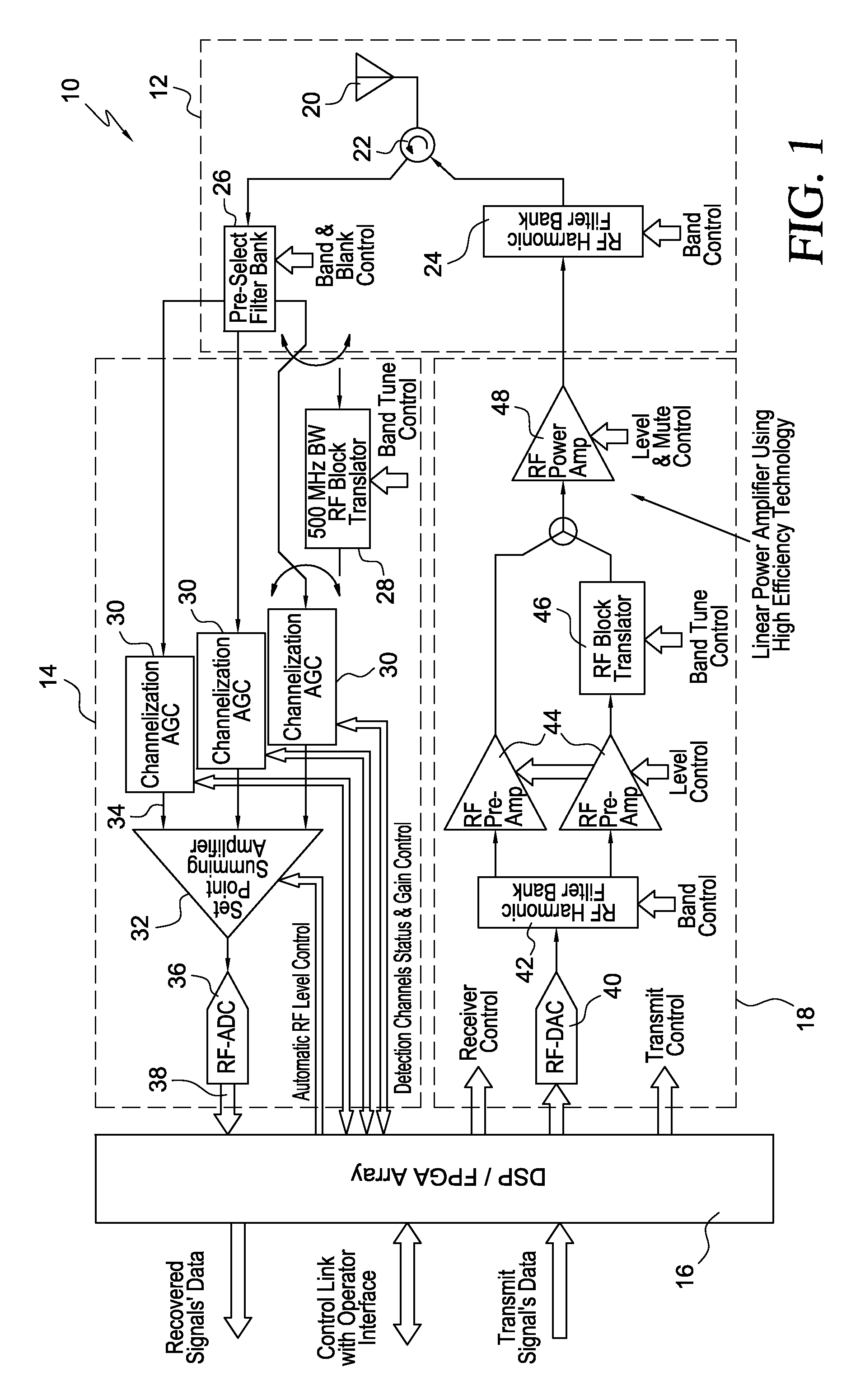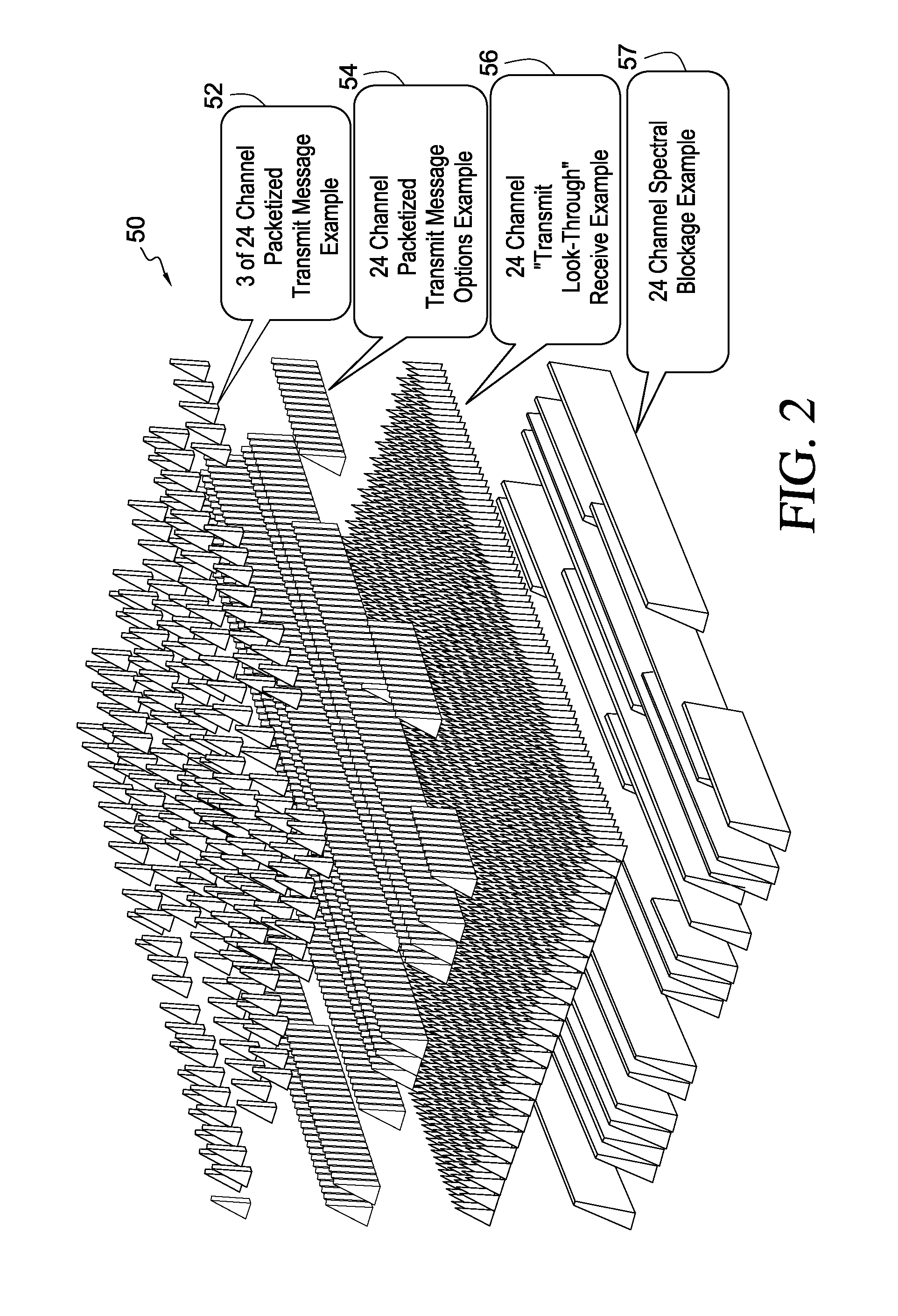[0007]A
transmitter system is operatively connected to the DSP array and to the
broadband antenna system, the
transmitter system includes at least one
transmitter subsystem. The transmitter subsystem includes a
radio frequency-digital-to-analog converter (RF-DAC) for receiving at least one modulated RF signal from the DSP array. The modulated RF signal has independent modulation from the other modulated RF signals for simultaneous transmission. A second RF
harmonic filter bank is operatively connected to the RF-DAC for the suppression of sampling process artifacts, including signals
harmonics. An RF pre-amp system is operatively connected to the second RF
harmonic filter bank for the
linear amplification of the RF signals to a working level for an
RF power amplifier. At least one block translator system is operatively connected to the RF pre-amp system for providing a frequency translation of a pre-amplified frequency block to a final
frequency band. An
RF power amplifier linearly amplifies pre-amplified frequency blocks with transmit signal content from the pre-amp system, as well as translated frequency blocks with transmit signal content from the block translators.
[0008]Thus, a set of cognitive waveforms are generated within the DSP array for transmission from the antenna system and
recovery processed within the DSP array for reception from the antenna system. Orthogonal
frequency division multiplexed (OFDM) data packets are interleaved with
short duration gaps, wherein the data packets are randomly distributed simultaneously over a subset of multiple unoccupied frequencies from an OFDM frequency set. The combination of the data packets in time and frequency provide a data message. The data packets are transmitted and the received channels signals activity is monitored during the
short duration gaps between data packets so as to maintain
rapid response to the changes in the spectral environment. The data packets further contain supervisory information and
error correction coding, in both time and frequency, to allow for robust message data reception and
recovery by users without prior time and frequency synchronization. The data packets are on subsets of the OFDM frequency set. The number of simultaneous packets can be increased to increase the overall message
throughput and decreased to respond to currently reduced numbers of unoccupied frequencies.
[0011]A coordinated
digital signal processing (DSP) array is operatively connected to the
staring receiver system for providing
digital signal processing of the receive and transmit signal sets, on a real-time basis, as well as management of the software defined and
staring cognitive
communications system from the digital domain. A transmitter system is operatively connected to the DSP array and to the
broadband antenna system. The transmitter system includes at least one transmitter subsystem. The transmitter subsystem includes a
radio frequency-
power output-digital-to-analog converter (RF-Power-DAC) for receiving at least one modulated RF signal from the DSP array. The modulated RF signal has independent modulation from the other modulated RF signals for simultaneous transmission. The RF-Power-DAC has output analog filtering to adequately suppress sampling signal artifacts from above the first Nyquist band. A low power
radio frequency-digital-to-analog converter (RF-DAC) receives at least one modulated RF signal from the DSP array. The modulated RF signal is negatively matched to the transmit leakage signal at the
broadband antenna system's summing element, for the purpose of further suppressing the transmit leakage in the
receiver system's RF signal input.
[0012]Thus, a set of cognitive waveforms are generated within the DSP array for transmission from the antenna system and recovery processed within the DSP array for reception from the antenna system. The orthogonal
frequency division multiplexed (OFDM) data packets are interleaved with
short duration gaps, wherein the data packets are randomly distributed simultaneously over a subset of multiple unoccupied frequencies from an OFDM frequency set, and whereas the combination of the data packets in time and frequency provide a data message. The data packets are transmitted and received channels signals activity is monitored simultaneously and continuously so as to maintain
rapid response to the changes in the spectral environment. The data packets further contain supervisory information and
error correction coding, in both time and frequency, to allow for robust message data reception and recovery by users without prior time and frequency synchronization. The data packets are on subsets of the OFDM frequency set wherein the number of simultaneous packets can be increased to increase the overall message
throughput and decreased to respond to currently reduced numbers of unoccupied frequencies.
[0014]Conventional radios are generally set up for single frequency, tuned channel operation on frequency sets defined by prior allocation. Typically it requires 100s of microseconds to 10s of milliseconds to change and restabilize the channel frequency. This makes the time to scan large bandwidths for signal content and respond accordingly significantly larger than desired. This long
delay precludes the reliable monitoring of the spectral content and the application of cognitive algorithms. Cognitive algorithms applied to conventional radios attempt to obtain timely information about the spectral environment and the nature of the signals present, such that operation is not limited to pre-allocated frequencies. If the system can reliably determine spectral signal activity on an ongoing, regional basis and effectively do so on a non-interfering basis with other signals, then the system can use these unallocated
idle channel spaces between signals present to transmit new signals.
[0015]Clearly, conventional radios are not responsive enough to perform as effective cognitive radios. On the other hand, if the radio has the capability to continuously receive and process all the ongoing signals present in a
wideband frequency block, including the recognition / characterization of all signals and the recovery of multiple desired signals, and then rapidly respond by transmitting as appropriate, multi-carrier, modulated signals, the system becomes an effective
cognitive radio. The present inventive concepts use massively-parallel fixed tuned receive channelization, along with
massively parallel digital signal processing and software generated, multi-modulated RF signals, to provide a system that is truly fast enough to cognitively manage the ongoing operation of multiple signals, multiple frequencies, and even multiple operations, all simultaneously. Changes in the received signals environment are typically detected, processed and responded to as much as 1,000 times faster than with conventional radios. In addition, the radio is also a true software defined
digital radio, where arbitrary frequency channelization, bandwidth control and
demodulation / modulation on multiple simultaneous signals are all performed in the digital (software) domain.
 Login to View More
Login to View More  Login to View More
Login to View More 


